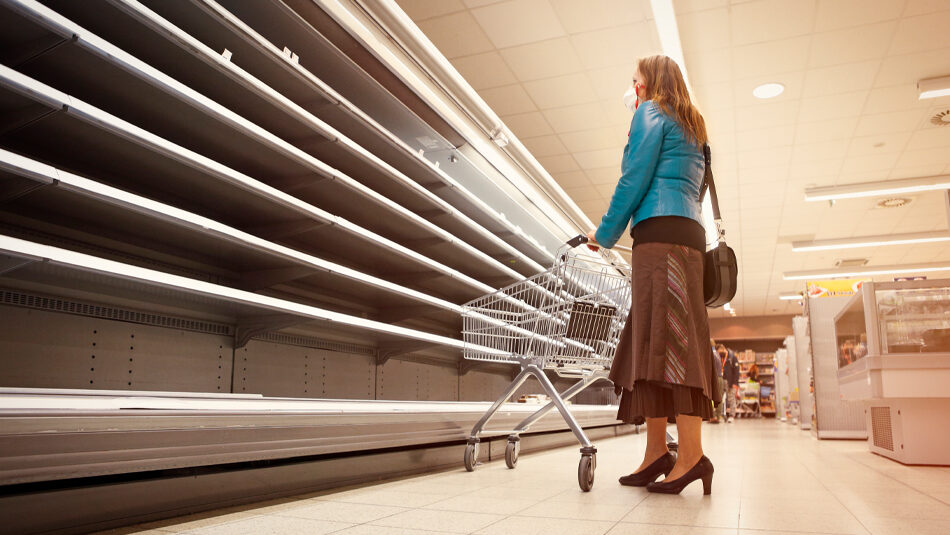
Record Sales & Empty Shelves: The Short- and Long-Term Impact of COVID-19 on Supermarkets
Businesses all over the country are shutting down as responses to COVID-19 increase daily. Meanwhile supermarkets are working around the clock. And they are one of the very few remaining places where people can’t avoid coming in close contact with each other.
As supermarkets scramble to stay ahead of rapidly changing conditions, there are multiple short-term challenges they are dealing with. Let’s review some of these first, and then take a look at the long-term implications.
The Top Short-Term Challenges for Grocers
Panic Buying
At first, hoarding was the big problem as shelves were wiped out. Stores were slow to set a limit on the number of the same item an individual could buy. However, most stores have now imposed limits, at the very least on the items most in demand. Now they are working hard to enforce these rules with added security measures needed on site in some case.
Stock Levels
Out-of-stock items still persist as the supply chain struggles to recover from the unprecedented consumer pull-through. In the weeks ahead, the situation should start to stabilize as the purchase limits begin to kick in. However, imported products, especially those from China, may take a lot longer to replenish the pipeline.
Training and Staffing
Online grocery shopping has skyrocketed, not surprisingly. Amazon and Walmart are each hiring 100,000 workers, and Instacart has announced the hiring of 300,000, to meet the demand for staff to fill and deliver the surge in orders . Even small independents have ramped up from having two employees filling orders to 20 in just one week. The demand has created another series of challenges, however.
Finding and training qualified workers will be a challenge in the short-term. With many restaurants closing down, employment as a ‘picker’ for supermarkets or Instacart can be a great option for laid-off restaurant workers. However, the people who can train them are stretched to their limits filling orders. This leaves little time for onboarding.
Online Ordering
Challenges abound with online ordering, and changes are being made on the fly. With delivery schedules maxed out, some stores are placing minimum basket size requirements so slots aren’t being wasted on unprofitable deliveries. Other stores are scrambling to get a more accurate read on out-of-stock items and alerting customers that a product is not available while they are ordering. Customers tend to be more upset when they discover while unloading that their whole order didn’t get filled.
With Instacart’s business model comparable to UBER drivers, workers rely on their reputation. Instacart shopper/drivers have begun to complain that they are getting low ratings from customers because they can’t fill out-of-stock items being ordered. This has a big impact on their tips and their chance to gain repeat business. Instacart responded with a change to their policy last week, saying that customer ratings during the pandemic would not be counted and so would not affect future earnings potential. Instacart workers continue to demand more safety measures and better pay as they struggle to meet unprecedented demand.
Safety Concerns
Customer and employee safety are a major concern. Changes are being enacted on an almost hourly basis. Most stores have instituted special hours when only the elderly and most at-risk can shop. Retailers are also limiting the number of customers allowed in to the store at any given time. Trader Joe’s and others have put marks on the floor to keep customers separated in line.
Albertsons just announced they would install plexiglass ‘sneeze guards’ at checkout in 2,200 stores, following Hy-Vee, who began installing them last week. Hy-Vee also announced a ban on reusable shopping bags, concerned that customers may not have sanitized them properly. Publix confirmed that an employee had tested positive for COVID-19, and enacted a heightened disinfection program.
Although there appear to be conflicting reports, government agencies state that there is no evidence that COVID-19 can be transmitted through food or food packaging. “The FDA does not anticipate that food will need to be held, recalled or withdrawn from the market due to possible exposure to SARS-CoV-2 through a person that has tested positive for the COVID-19 virus that works a food facility,” according to a document on the FDA website.
Home delivery safety measures are also being put in place, with drivers ‘porching’ deliveries to reduce contacts. Kroger is piloting a ‘pickup only’ store in Cincinnati, a model which minimizes interaction between customers and employees.
Employee Satisfaction
Stores are taking extraordinary measures to keep employees happy at a time when they are being asked to work under difficult circumstances and are in high demand.
Many chains are increasing wages and/or adding immediate bonuses to compensation packages. Kroger is giving all full-time frontline workers a $300 bonus, and Walmart is spending $550 million in additional bonuses. Stop & Shop is giving workers a 10% pay raise, while Whole Foods and Wegmans are giving $2 an hour raises to their employees effective immediately.
The Long-Term Impact of COVID-19 on Grocers
Supermarkets are focused on short-term issues right now. But here are a few longer-term issues that I feel will soon be coming to bear.
Global Food Supply Chain Disruption
The United Nations Food and Agriculture Organization (FAO) warns of a major disruption of the global food supply chain. They warn that border closures, trade disruptions, transport challenges, labor shortages, and even the isolation of small farmers will be “particularly obstructive for fresh food supply chains like fruits and veggies.” They predict that these issues will have an impact as early as next month.
One response to the shifting logistics needs comes from US Foods. They announced a partnership with C&S Wholesale Grocers to shift underutilized US Foods employees to help C&S deal with a huge increase in demand for workers by supermarkets. Sysco, Albertsons/Safeway and others have also entered into similar agreements to help deal with the massive shift of food consumption from restaurants to grocery stores.
Potential Worker Shortages
The US State Department stopped processing guest worker visa program applications on March 18th. Produce farmers rely heavily on these seasonal workers to bring in the harvest of fruits and vegetables which is about to move in to peak season. The possibility of major supply disruption and/or price increases cannot be ruled out.
Update: As of March 25th, the State Department reversed itself and has resumed processing visas.
Online Shopping Logistical Nightmares
A massive ‘sampling program’ is underway as consumers are trying online ordering and delivery of groceries for the first time, whether they like it or not. But the chances are a lot of people will find it to their liking and convert to this new habit permanently. Such a sudden switch at levels never previously anticipated will inevitably cause logistical nightmares, especially when many operators are still struggling to maintain profitability with delivery and had high hopes of moving customers toward the ‘order online/pick up in store’ model.
Shifting personnel needs will be the earliest and easiest to solve. But it is entirely possible that people will never return to their pre-pandemic habits, and that isolation from crowds will become a choice that leads to a major shift to delivery of groceries (along with everything else).
If that happens at a far more accelerated pace than previously anticipated, will brick-and-mortar supermarket locations need to be scaled back rapidly, adding to the already alarming number of empty storefronts sweeping the shopping centers of the country? And will the current increase in hiring by supermarkets give way to a steady decline in the number of jobs that led to the upward mobility of many Americans in the past 50 years?
Brick & Mortar Needs Further Updates
If there is a permanent shift to online grocery shopping, will brands that rely on impulse purchases have to find new avenues for generating sales? Perhaps the recent trend of convenience stores carrying more fresh foods will continue and a new hybrid store format will emerge.
The Future Brings New Opportunity for the Entire Food Industry
It’s important to note that there are good things happening though. Supermarkets are stepping up to help out the restaurant industry and their employees. Albertsons is hiring 30,000 part-time workers, many furloughed from the restaurant industry, knowing they will return to their restaurants when the crisis is over. Other chains, some as small as Sedano’s in Florida with 35 units, are doing the same. Rouse’s Markets in New Orleans is providing meals to go from some of the leading local restaurants for sale, which gives those restaurants another outlet for their ‘to-go’ business.
And as people cook more at home and have more time to do so, there is a definite silver lining to all the challenges we’re facing. Produce sales are through the roof. And since produce is perishable, this is not hoarding behavior. With more ‘made from scratch’ cooking, there are definitely going to be more healthy meals consumed.
The one thing we can be sure of is that things will not go back to being the same. Flexibility and a willingness to try new things will be the new “normal,” and it is required now more than ever.


